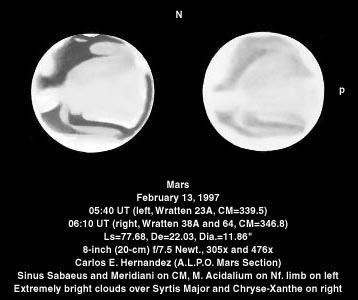

The red light (Wratten 23A) drawing of Mars on the left was made on February 13, 1997 (Ls=77.68 and De=22.03) at 05:40 UT (CM=339.5) by Carlos E. Hernandez (A.L.P.O. Mars Coordinator) using an 8-inch (20-cm) f/7.5 Newtonian reflector at 305x and 476x. The North Polar Cap (NPC) appears brilliant (10/10) and small with an extremely bright (9/10), thin, curvilinear outlier (possibly Cecropia) p. the CM. The NPC is surrounded by a dark (3/10) collar consisting of Cecropia, Ortygia, and Baltia. Mare Acidalium appears dark (3/10) f. the CM with its f. border partially obscured by an extremely bright (9/10) morning limb Haze (MLH). A dark (3/10) projection is noted from the Np. border of M. Acidalium consisting of Deuteronilus (at brief moments of very steady seeing Ismenius Lacus could be made out as well). The Chryse-Xanthe region appears very bright to extremely bright (8-9/10). The dark (3/10) "pipe-like" albedo feature on the CM is comprised of Sinus Sabaeus (the "stem") and Sinus Meridiani (the "bowl"); the latter representing 0 degrees longitude and 0 degrees latitude on Mars (specifically within the 32 miles (57 km) diameter crater Airy-O). Syrtis Major is visible adjacent to the terminator as thin, dark (3/10) albedo feature surrounded by a very bright to extremely bright (8-9/10) cloud which merges with an extremely bright (9/10) MLH. Mare Serpentis is visible just south of the p. end of Sinus Sabaeus as a dark to dusky (3-4/10) albedo feature. Margaritifer Sinus appears dark (3/10) as well as Vulcani Pelagus Sp. (or southeast of) it. Mare Erythraeum appears dark to dusky (3-4/10) but is partially obscured by an extremely bright MLH and southern limb haze (SLH).
The blue (Wratten 38A) and blue-green (Wratten 64) light drawing of Mars on the right was made on the same date, and instrument, as the previous drawing at 06:10 UT (CM=346.8). The NPC appears brilliant (10/10). Extremely bright (9/10) morning limb (MLH) and evening limb (ELH) hazes are noted apparently connected by what appears to be a bright to very bright (7.5/10) equatorial cloud band (ECB) across Eden, Moab, Arabia, and Aeria. Mare Acidalium, Sinus Sabaeus, Sinus Meridiani, and Margaritifer Sinus all appear dusky to dull (4-5/10) as well as diffuse. An extremely bright southern limb haze (SLH) is noted as well.
(Legend: N.=north, S.=south, p.=preceding, f.=following, Np.=north-preceding, Nf.=north-following, Sp.=south-preceding, Sf.=south-following)